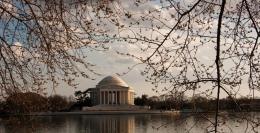On March 27, 1912, American first lady Helen Taft and Viscountess Chinda, the wife of the Japanese ambassador at the time, planted two cherry trees along the banks of the Potomac River in Washington, D.C. This small gesture, intended as a tribute to the nascent friendship between the United States and Japan, kicked off a spring tradition in the District that celebrates its 100th anniversary this year.
Since 1935, the National Cherry Blossom Festival has dependably come around every year as the cherry trees bloom. Just as more cherry trees have arrived in the District over the years, the festival has grown, now heralding the arrival of spring for Washingtonians and the many visitors from around the country and world who stream into the District during the cherry blossom festival season.

This year, the festival continues its expansion as an institution promoting culture, community and Japanese heritage in the District, seizing the occasion of the centennial as an opportunity to usher in new traditions and continued growth.
The festival isn’t departing from its longstanding traditions that visitors enjoy, according to National Cherry Blossom Festival Communications Manager Danielle Piacente, but rather taking advantage of the occasion to build on those traditions and start new ones.
This year, the festival will run for more than a month, five times its traditional length; this significant change marks the centennial celebration.
“We’re expanding the annual celebration and the National Cherry Blossom Festival from six days to five weeks,” Piacente said. This year’s festival begins on the first day of spring, March 20, and lasts through Arbor Day, April 27.
Aside from the extra-long festival itself, there will also be a great deal of commemorative merchandise sold during this time. The Cherry Blossom Festival has partnered with National Geographic to produce Cherry Blossoms: The Official Book of the National Cherry Blossom Festival.
However, the emphasis remains on the celebratory activities that characterize the festival. Though the festival is longer, the cherry blossoms themselves will still be in “peak bloom time” for less than a week, according to the National Park Service.
To maintain interest in the cultural touchstone even after the flowers have gone, the festival planning team has launched the City in Bloom campaign. City in Bloom is an attempt to spread the spirit of the National Cherry Blossom Festival throughout the DMV region. As part of the campaign, major D.C. attractions like the Newseum, the National Archives and even Dulles International Airport, will feature window decals and bright pink lighting, imbuing them with a festive, spring-like spirit.
Along with the buildings that will be “in bloom” this year, old Cherry Blossom Festival events will have a new spotlight thrust upon them.
“Our signature events have been elevated,” Piacente said.
This will be noticeable from the start of the festival. The opening ceremonies are being treated as a stand alone event for the first time in the Festival’s history. They will be held at the Walter E. Washington Convention Center, a 6,000 seat venue, and will feature performances by pop singer Sara Bareilles and, in a tribute to the Festival’s Japanese roots, Japanese pop artist Misha.
The excitement will not end once opening ceremonies do. The Festival’s parade will be nationally televised for the first time and will feature celebrity hosts Katie Couric and Alex Trebek.
Piacente noted that though there is always broad national and international interest in attending the Cherry Blossom Festival, according to, this year has seen a particularly international attendance base, with many more people visiting from Japan and major entertainment acts.
Aside from its traditional events, the Festival offers a number of musical performances and other shows and will have three stages this year. Those stages include the Canon Performance Stage at the Sylvan Theater near the Washington Monument and a jazz center at the Jefferson Memorial Stage, both of which offer attendees the chance to enjoy the participating acts in unique D.C. environments.
Organizers also highlighted the Cherry Blast Party on Saturday, April 21, a 21-plus event hosted in a warehouse with numerous arts and cultural activities occurring simultaneously.
“There’s a surprise at every corner,” Piacente said.
The Cherry Blossom Festival is the product of year-round work by a dedicated group of full-time, paid employees as well as volunteers. The Festival’s full-time staff includes 10 employees this year, which is more than it has had in past years, and they rely on the occasional support of outside contractors, as well as the work of 1,000 volunteers.
They also strive to keep Japanese cultural groups in the District involved in the planning of the Festival, drawing on the support of such organizations as the Japan-America Society of Washington D.C., a nonprofit membership organization that, according to its website, “promotes greater understanding and networking between Americans and Japanese through its many cultural, public affairs and educational programs.”
The Japanese Embassy also works actively with festival organizers.
The centennial anniversary of the planting of the trees by the Japanese ambassador’s wife and the American first lady comes on the heels of the one-year anniversary of the devastating March 11, 2011 earthquake and tsunami in Japan. Last year, the Festival wove relief efforts for earthquake victims into its work, but one year later, with Japan recovering from the effects of the earthquake, the emphasis is again on celebrating the vibrancy of Japanese culture and Japanese-American friendship.
“The message that we’ve gotten through … the embassy is that ‘Japan is back. Japan is blooming,’” Piacente said.
It’s a fitting message to guide the work of a Festival that’s been blooming for a century.







